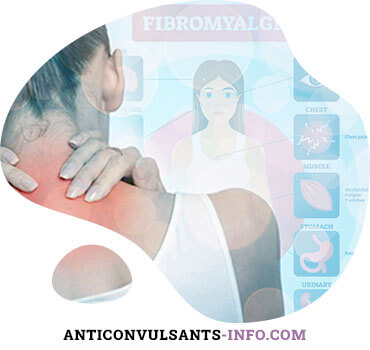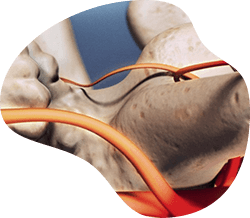Musculoskeletal pain - fibromyalgia
Evolution of views and the definition of fibromyalgia. Etiology, pathogenesis, symptoms, nosological essence and diagnosis of chronic musculoskeletal pain syndrome. The course of the disease and methods of its treatment. The use of ibuprofen.
In the past two decades, fibromyalgia (FM) has taken a strong place among the most pressing issues of modern medicine. Interest in FM is primarily associated with the evolution of views on its nature and the refusal of most researchers to consider it as an inflammatory disease of muscle tissue, in connection with which FM was squeezed out of the narrow framework of rheumatological problems and its formation is increasingly an interdisciplinary problem. At the same time, studies in recent years have identified a number of psychiatric and neurological aspects in it.

The term "fibromyalgia" has acquired the disease only in recent years, although it has more than 150 years of history, i.e. since when the terms “fibrositis”, “fibromyositis”, “tendomyopathy”, “myofibrillosis”, “muscle rheumatism”, “psychogenic rheumatism” began to be used to refer to musculoskeletal pains, and on the other hand, to connect these disorders with concepts pain points and trigger zones.
Criteria of the American College of Rheumatology (N. Smyth, M. Yunus, 1990):
1. The presence of generalized symmetrical pain (extending to the right and left, upper and lower half of the trunk, or axial), lasting at least 3 last months.
2. Pain on palpation of at least 11 out of 18 (9 pairs) of specific sensitive points. Use the following points:
- occipital region - place of attachment m. suboccipitalis;
- neck region - the anterior parts of the space between the transverse processes of CV - CVII;
- trapezius muscle - the middle of the upper edge;
- supraspinatus muscle at the site of its attachment;
- the zone of articulation of the II rib with the sternum along its upper edge;
- a point located 2 cm distal to the external epicondyle of the shoulder;
- in the gluteal region - the upper outer quadrant of the buttock along the front edge of the muscle;
- a large spit of the thigh;
- in the area of the knee joint - medial fat pad.
Although the question of the nosological nature of FM is debatable, its distinct not only clinical but also pathophysiological independence should be recognized, which was the reason for the discussion of FM as a possible primary disease.
The result of multicenter studies of leading institutions for the study of this disease was the creation of diagnostic criteria for a positive diagnosis of FM, which combined all the existing criteria.
The use of these criteria allows for a "reliable" (if all criteria are available) and "possible" (with insufficient number of sensitive points) FM diagnosis. The presence of another clinical pathology does not exclude the diagnosis of FM. Therefore, strictly speaking, the existing criteria for the diagnosis of FM imply a syndromic diagnosis of FM with the exclusion of all possible other causes of a similar symptom complex. Thus, FM can be considered, on the one hand, a syndromic diagnosis, and on the other hand, an exclusion diagnosis.
The concept of "sensitive point" (CT), used in all modern criteria, is generally accepted for FM. CT is almost the only specific sign of this disease. Although the number of positive points in patients with FM can be very different (described up to 70 CT in one patient), their location and number is a unified system that facilitates the process of diagnosing this symptom complex. Therefore, the value of CT for verification of FM is very large. CT also have their own characteristic features: firstly, to cause pain, a light effort is enough; secondly, with palpation, you can get the pain that occurs in patients spontaneously (the phenomenon of "reproducibility of pain"); thirdly, CTs are located in strictly defined anatomical zones, i.e. there is a specific map of their localization, which is given in modern criteria.
FM is a chronic disease that lasts for years and even decades, dramatically worsening the quality of life of patients and, as a result, leading to severe maladaptation. This is not only a medical, but also a big social problem, the damage from which, in the USA in particular, amounts to tens of millions of dollars a year. As a result of this disease, about 30% of patients lose their ability to work, and about 5% become maladaptive in everyday life.
FM is one of the most common forms of chronic pain syndromes. Epidemiological studies indicate a high prevalence of FM (2-6% in the population) among all ethnic, social and age groups.
Due to established traditions, patients with FM are most represented in rheumatological practice. In neurological practice, this is also a fairly common pathology. Nevertheless, a paradoxical situation is observed, namely that the diagnosis of FM, even a syndromic one, is in principle absent in the everyday practice of medical specialists. The reason for this, on the one hand, most likely lies in the variety of clinical manifestations of FM. Such patients are most often evaluated by neurologists in accordance with the leading comorbid manifestations ("panic attacks", tension headaches, common osteochondrosis, myofascial syndrome, osteoarthritis, etc.). And on the other hand, the reason is an underestimation of the importance of mental disorders and stress for these patients and the absence of generally developed ideas and views on this symptom complex as a single suffering. Undoubtedly, such patients are also found in the practice of psychiatrists, who, however, do not make the patient diagnosed with FM, since they do not undergo a detailed analysis of the patient's physical condition and do not examine sensitive points in them.
Clinical picture
FM is defined as non-rheumatic non-articular diffuse (common) symmetrical pain, which is chronic in nature and is accompanied by stiffness, depression, sleep disturbances and the presence of characteristic pain points.
The disease can occur at any age, but prevails in people of the most working age (25-45 years). Among patients, a significant predominance of women (10: 1).
The course of the disease is chronic. Symptoms of FM may fluctuate as a result of exposure to provoking factors. Such factors are physical overwork, prolonged posture, staying stationary, emotional experiences, as well as cold and humidity. Pain is relieved by exposure to heat, massage, after rest, alternating with short periods of physical activity.

The basis of all clinical manifestations of FM is pain, which is present in 100% of patients, has characteristic features and is an obligate sign of FM. Pain is the main reason for the treatment of such patients to doctors, and it is for this reason that they often go to rheumatologists. Along with the fact that this is, as a rule, generalized pain, painful sensations can also have a predominant localization, in connection with which patients complain of pain in the neck, head, etc. The phenomenon of "pain everywhere" is characteristic - when, with an active questioning of the patient, it is not possible to identify a zone free of pain. Interestingly, there is an obvious dissociation between the intensity of pain (which patients themselves evaluate) and the degree of experience of these sensations. By nature, this pain is often monotonous, debilitating and wearing all the features of chronic pain. Its intensity, however, can increase dramatically, then this condition is referred to as a “fibrosite storm”. Cases are described when patients were subjected to surgical interventions due to these pains.
A special place in the overall picture of the clinical manifestations of FM is occupied by depressive disorders, which are almost obligate for her. Depression is the main reason for the deterioration in the quality of life of patients. Complaints about a depressed mood, narrowing of the circle of interests and loss of a sense of pleasure are quite typical in these cases. But such a clinically obvious variant of depressive disorders is observed in only half of patients. In other cases, depression is hidden under the mask of a wide variety of vegetative, somatic and numerous algic manifestations. In these cases, it is more appropriate to talk about the presence of latent or somatized depression in FM. The high conjugation of chronic pain and depression is especially typical for FM in the main clinical manifestations, type of course, reaction to all types of antidepressant therapy.
One of the most striking clinical manifestations of FM is sleep disturbance. In the literature, sleep with FM received the characteristic name "non-restorative" because of the peculiar complex of typical complaints about the lack of feelings of relaxation after sleep, when patients wake up with a feeling of fatigue, and they describe the dream as superficial, restless. Actually, one of the reasons for the increased interest in the problem of FM was the study of the Canadian researcher H. Moldofsry, who in 1975 described a characteristic phenomenon for FM, called the "alpha delta dream." It consists in the fact that fragments of high-frequency oscillations of alpha waves are included in the structure of the deep stage of sleep, characterized by low-frequency high-amplitude delta waves. Subsequently, this phenomenon was confirmed by the results of most studies and became characteristic of FM. Although it is not absolutely specific for FM, since earlier in some studies it was shown in patients with depressive disorders, which perhaps once again demonstrates the proximity of their pathophysiology with FM.
The presence of morning stiffness, which is observed in 91% of patients, is also characteristic of FM. Its duration ranges from several minutes to several hours. To get rid of this sensation, patients often apply heat, exercise. However, the presence of asthenia, which is also characteristic of these patients, limits the possibilities of physical activity of patients and causes them to remain without movements for a long time, which further aggravates stiffness and pain.
Articles
In addition to the described obligate symptoms, FM is characterized by a whole symptom complex of psycho-vegetative, psychosomatic and various algic disorders, which are several times more common in FM than in the population. High conjugation with FM allows us to consider them as comorbid. The most common among them are the following: panic attacks, hyperventilation syndrome, tension headaches, migraines, lipothymic conditions, irritable bowel syndrome, cardialgia, abdominalgia, Raynaud's syndrome, myofascial pains, etc. It should be emphasized that in one patient, as a rule, one can find a whole symptom complex of the above-mentioned disorders, the dominance of which in the clinical picture often makes it difficult to distinguish “actually fibromyalgic phenomena”, which is reflected in the interpretation of these patients and, as a result In order to master the diagnosis (tension headaches, chronic myofascial syndrome, etc.).
The relationship of FM with myofascial pain syndromes of a predominantly chronic course is especially discussed. There are several views on the nature of these relationships - both the recognition of fundamental differences between them, and the consideration of one clinical variant of another.
Our team (leader - S. B. Korotkova) examined 60 patients with FM and 20 patients with chronic myofascial syndromes (MFS). The diagnosis of FM was established in accordance with the main generally accepted criteria (1990). 87% of patients with FM abandoned their usual professional activities, and 67% had a disability group for the underlying disease. The degree of maladaptation of these patients was also confirmed using special tests. According to the results of the MMPI test, the averaged personality profile of patients could be characterized as anxiety-depressive with hypochondriacal tendencies, and according to the Beck test data, the average degree of depression in these patients could be ascertained. When studying the test data for pain management strategies, it was shown that among the complex of emotional-behavioral reactions that occur in response to pain, passive strategies prevailed in patients with FM (catastrophic, the desire for social support, hopelessness and helplessness, restrictive behavior). Along with this, in patients with FM it was possible to note significantly higher rates of reactive and personal anxiety according to the Spilbeger test, as well as a higher representation of autonomic dystonia syndrome. All these violations significantly distinguished patients with FM from the control group, and the corresponding indicators of patients with MFS were within normal limits.
Clinically, one could distinguish the fundamental differences between these two groups of patients. With FM, the onset of the disease after a stressful situation was significantly more often observed (87%) and much less often the disease was preceded by trauma and prolonged stress caused by posture (opposite correlations were observed in patients with MFS). The pain with FM in all patients was of a chronic diffuse nature, was symmetrical, its intensity depended on the emotional state of the patients, quality of sleep, and weather factors. Pain with MFS was more often local in nature and was strictly associated with postural overstrain and correlated with a separate muscle group. Fundamental differences were characterized by CT in patients with FM and trigger points in patients with MFS. Palpation of trigger points is distinguished by the presence of a pain pattern and a zone of reflected pain, often far from the trigger (this pain does not obey the principles of radicular or segmental irradiation), and is also accompanied by a "jump symptom".
These groups are fundamentally distinguished by the results of the study of the nociceptive flexor reflex, which makes it possible to generally assess the state of pain and analgesic systems. In patients with FM, there is a gross decrease in the thresholds of the subjective assessment of pain and the threshold of the flexor reflex, which indicates a violation of the interaction of noci and antinociceptive mechanisms. These results are consistent with the results of studies of somatosensory evoked potentials (SSEP). In patients with FM, a significant increase in the amplitudes of the early (H0, N0, H1) components was obtained, which reflects an increase in the activity of specific afferentation mechanisms, and in conditions of lowering pain thresholds, it may indicate a lack of mechanisms that control the intensity of sensory afferentation. Such a complex of clinical and psychophysiological features of FM allows us to talk about the special independence of this symptom complex, in which psychic, autonomic processes and systems that control pain mechanisms interact in a special way on a clinical and psychophysiological level. This fundamentally distinguishes FM in general and from IFS in particular.
Such attempts to strictly distinguish between MFS and FM in practice are not always justified, since it is often possible for the same patient to detect signs of FM in the presence of local pain phenomena that bear all the features of myofascial pain. This is not paradoxical, because in the light of ideas about FM as a model of chronic pain-depression, in which the functioning of systems that control pain is disrupted. From these positions, it becomes clear that in patients with a reduced tolerance to pain, habitual, as well as stress caused by posture, ceteris paribus, can quickly and easily form various algorithmic phenomena, including myofascial pain.
Treatment
Treatment of patients with FM is a difficult task. Non-pharmacological treatment methods include various modifications of psychotherapeutic approaches, autogenous training, and biofeedback methods.
Since FM is a chronic disease that has been going on for decades, as a rule, patients have a long experience of using various analgesic drugs, which have a disappointing result. Therefore, the appointment of analgesics should be justified. Among this group, preference should be given primarily to non-steroidal anti-inflammatory drugs that can be used for a long time and which are more safe (ibuprofen). These drugs are well used in the form of creams and ointments. In some cases, using drugs that have a muscle relaxant effect - tizanidine. However, it is clear that such treatment is symptomatic.
Among all groups of pharmacological agents, the use of antidepressants is most justified. Tricyclic antidepressants (amitriptyline, nortriptyline), serotonin-increasing drugs are widely used: sertraline, fluoxetine, paroxetine and other classes of antidepressants. Benzodiazepines (alprazolam) are considered less effective. In recent years, attempts have been made to use botulinum toxin preparations for the treatment of patients with FM. However, their effectiveness is still difficult to evaluate. Our experience in treating patients with FM allows us to highlight some features of approaches to treatment tactics and the choice of the most effective pharmacological and non-pharmacological methods. The first group of patients was treated for 6 weeks with a selective serotonin reuptake inhibitor fluoxetine at a dose of 20 mg / day. The second group - a 6-week course of treatment with a four-cycle antidepressant mianserin at a dose of 30 mg / day. The third group of patients - a 2-week course of treatment with the non-steroidal anti-inflammatory drug ibuprofen at a dose of 800 mg / day. The fourth group for the correction of sleep disorders is a 10-day course of melatonin at a dose of 1.5 mg at night. The fifth group is phototherapy (treatment with bright white light, a course of 10 procedures). This method is well established for the treatment of patients with seasonal affective disorders.
Assessing the overall comparative effectiveness of these treatment methods, we can say that the effect of fluoxetine and phototherapy, to a lesser extent mianserin, was the most pronounced antidepressant and analgesic. Other pharmacological treatment methods had a selective effect (ibuprofen had only a certain analgesic effect, and melatonin had a positive effect on the characteristics of night sleep), so patients evaluated their use as ineffective. Thus, we can conclude that the choice of treatment method for patients with FM should be based on the possibilities of analgesic, antidepressant effects, i.e. affect the main core - depression, pain. In this sense, the greatest result can be achieved with complex therapy.
 DE
DE FR
FR IT
IT ES
ES









